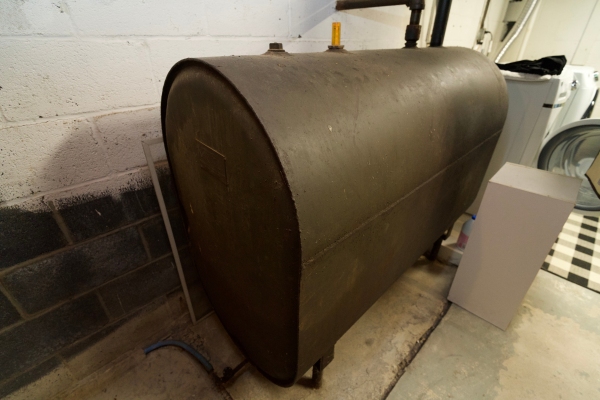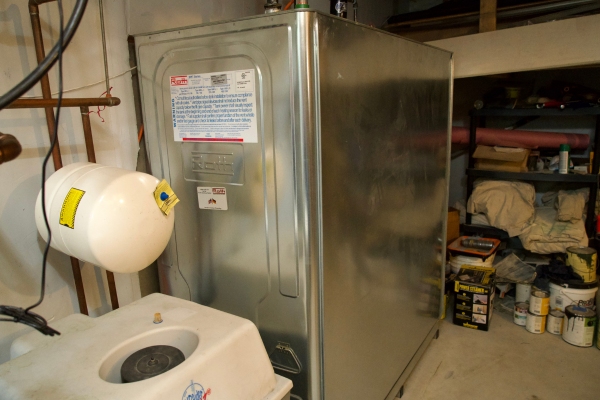Contents
- 1 Choosing the Right Heating Oil Tank Size
- 2 Deciding When to Upgrade Your Home Heating Oil Tank
- 3 Overview of Typical Heating Oil Tank Size for Homes
- 4 Key Considerations for Choosing a Heating Oil Tank
- 5 Engaging a Professional for Oil Tank Installation
- 6 Heating Oil Tank FAQs
- 6.1 Is It Possible to Use Two Smaller Tanks Rather Than One Large Tank?
- 6.2 What Actions Should I Take If Rust or Corrosion Appears on My Tank?
- 6.3 Is Regular Cleaning of My Oil Tank Necessary?
- 6.4 Does Climate Influence the Choice of Tank Size?
- 6.5 What is the Correct Way to Dispose of an Old Oil Tank?
- 7 Conclusion
- 8 Contact Noonan Energy for Trusted Heating Oil Delivery Services
Homeownership brings a range of duties that can sometimes cause us to neglect critical areas of upkeep, like our HVAC systems—especially those that utilize heating oil. If you’re settling into a new home with an established oil heating setup or it’s been some time since your last oil tank check, this moment is vital for giving it some attention.
Heating oil is crucial for keeping your home cozy, safe, and warm, mainly through the chillier seasons. The worst scenario is running out of oil amidst harsh weather, which can complicate timely refills. It’s vital to be proactive about managing your oil levels, especially if you depend on will-call or COD (Cash on Delivery) methods for your deliveries.
Moreover, when contemplating a replacement for your heating oil tank, it is crucial to evaluate whether the existing tank’s size suits your household’s oil usage. Selecting an appropriate heating oil tank size enhances your heating efficiency and guarantees a sufficient oil reserve to last the entire winter, reducing the need for constant top-ups. Keep reading this article from Noonan Energy to learn more.
Choosing the Right Heating Oil Tank Size

As discussed, numerous homes depend on heating oil for warmth. Understanding your home’s heating demands is essential if this is your primary heating source. Knowing your household’s fuel consumption patterns allows you to accurately identify the best heating oil tank size for your needs. Furthermore, being aware of your tank’s capacity helps you proactively manage fuel deliveries, ensuring you’re never caught without oil when you need it most.
Knowing the size of your oil tank is critical for several reasons:
- Estimating Remaining Heating Oil: Understanding your tank size is critical to knowing how much oil you have left. Many older tanks don’t come with gauges to show low levels. In these instances, a simple calculation can reveal how much oil remains.
- Calculating Oil Purchase Needs: Knowing your oil tank size and the current oil level enables you to precisely determine how much more to buy to ensure you make it through the winter. This facilitates effective planning and budgeting.
- Grasping Your Consumption Patterns: Knowing your heating oil usage helps you become a more informed and efficient consumer. This insight can lead to improved heat conservation efforts in your home.
- Preventing Oil Shortages: Understanding your oil tank’s capacity is vital to avoid depleting your supply. This is especially important during cold months when the absence of heating oil can pose risks, mainly if there are vulnerable individuals such as children or elderly family members in your household.
Stay warm all winter with Noonan Energy’s reliable heating oil delivery services—contact us today!
Deciding When to Upgrade Your Home Heating Oil Tank
When considering upgrading your existing heating oil tank, knowing the specific reasons behind the need for an upgrade can streamline your decision-making process, especially when choosing the right size for your new tank. Common triggers for an upgrade include:
- Oil Tank Age & Wear: If your current home heating oil tank is aging and exhibits signs of deterioration, it may no longer be safe or efficient. This makes upgrading to a more modern and reliable model essential.
- Adjustments in Heating Needs: If your family size increases or if you make changes to your home’s layout, your heating requirements might change as well. A current tank that no longer fits your increased heating needs will require upgrading to a larger capacity.
- Economic Advantages of Bulk Fuel Oil Buying: Utilizing bulk purchase discounts can yield considerable savings on heating oil. Opting to buy oil less often and aiming for long-term cost efficiency might necessitate a bigger oil storage tank to hold larger oil quantities.
Overview of Typical Heating Oil Tank Size for Homes

Grasping the fundamentals of heating oil tank dimensions is essential when evaluating tank sizes. ‘Capacity’ denotes the maximum volume of oil a tank can hold, usually measured in gallons for residential use. Additionally, the tank’s physical dimensions—width, height, and depth—are measured in inches, contributing to its total capacity assessment.
You must first determine the capacity of your current tank to choose the right size for a replacement oil tank. Older tanks often lack size labels, necessitating manual measurements with a tape measure to establish dimensions and compute capacity. Modern tanks, however, typically come with labels that clearly indicate their size, making the process easier.
For residential applications, the typical oil tank size is around 275 gallons. However, various other sizes are available, such as 288, 340, 420, 500, 550, 675, and 1000 gallons. In commercial settings, tanks are much larger, with capacities that can exceed 30,000 gallons, meeting the extensive heating demands of commercial enterprises.
Trust Noonan Energy for timely and efficient heating oil deliveries to keep your home heated through the winter.
Key Considerations for Choosing a Heating Oil Tank

Selecting the right size for a heating oil tank depends on various factors, primarily your household’s oil consumption. Here are some important considerations to keep in mind when determining the appropriate tank size for your home:
- Oil Tank Space Availability: Evaluate the physical dimensions of your existing tank if you’re considering an upgrade to a larger size. This will help you understand whether you have enough space to accommodate a bigger tank.
- Household Size: The number of people living in your home significantly influences your heating needs. As your family expands, your oil consumption will likely increase during the colder months, necessitating a larger tank to maintain warmth and comfort for everyone.
- Home Size: A practical guideline for selecting an oil tank size is based on the number of rooms in your house. Smaller tanks typically suffice for homes with one to two bedrooms, while larger homes with five or more bedrooms require bigger tanks to meet their heating needs efficiently.
- Heating Oil Consumption Patterns: Consider your household’s heating habits. If you are conservative in your heating oil use, this affects the tank size you need—additionally, factor in your travel habits. If you often vacation during the winter, your consumption decreases, affecting the necessary tank size.
- Planning for Emergencies: It’s wise to prepare for a buffer of at least 20% beyond your typical fuel usage to handle unexpected situations. For instance, in the event of a severe snowstorm, delivery delays could occur, so it is essential to have extra fuel on hand.
Engaging a Professional for Oil Tank Installation
Once you’ve evaluated your family’s heating oil requirements and selected the appropriate tank size, the next step is to engage a certified heating oil tank supplier for installation. A professional contractor will confirm that the chosen tank size meets your needs and will manage the installation process to ensure it is performed safely and proficiently.
Professional heating oil tank installers ensure that your tank is optimally positioned within your home for easy access and secure attachment to a solid foundation, which is crucial for preventing hazardous situations. They also take precautions to shield the tank from potential risks, such as extreme temperature drops, which could lead to a frozen heating oil system. By adhering to industry-standard protocols, these professionals mitigate all associated risks during installation.
Secure your home’s warmth with Noonan Energy’s professional heating oil delivery solutions—call us today to learn more!
Heating Oil Tank FAQs

Here are some common questions about heating oil tanks to help you understand more about your home heating system.
Is It Possible to Use Two Smaller Tanks Rather Than One Large Tank?
Yes, using two smaller tanks to reach a desired higher capacity is possible. This arrangement provides greater flexibility in managing your oil reserves and simplifies installation and maintenance compared to a larger tank. Additionally, this setup offers redundancy, allowing one tank to keep supplying oil if the other needs servicing.
What Actions Should I Take If Rust or Corrosion Appears on My Tank?
If you detect rust or corrosion on your oil tank, it’s crucial to act swiftly. Such conditions can jeopardize the tank’s structural integrity. Contact a professional for a thorough inspection. Addressing this issue promptly can avert leaks, environmental harm, and potential system breakdown, safeguarding the reliability and durability of your oil supply system.
Is Regular Cleaning of My Oil Tank Necessary?
Yes, regular cleaning of your oil tank is essential for maintaining efficiency and prolonging its lifespan. Cleaning helps eliminate sludge and debris that could clog filters and impair the functionality of your heating system. Furthermore, using heating oil additives can boost the fuel’s efficiency and longevity by preventing fuel degradation and corrosion inside the tank. These additives help preserve the quality of your heating oil, leading to smoother operation and possibly fewer maintenance requirements over time. Consult your oil supplier for advice on suitable additives to enhance your system’s performance and durability.
Does Climate Influence the Choice of Tank Size?
Yes, climate plays a significant role in determining the appropriate tank size. In colder regions with prolonged heating seasons, opting for a larger tank is advantageous to maintain a consistent oil supply throughout the winter. On the other hand, in areas with milder weather, a smaller tank might suffice due to the reduced heating requirements, which lowers the frequency and volume of oil needed.
What is the Correct Way to Dispose of an Old Oil Tank?
Correct disposal of an old oil tank is crucial to preventing environmental risks. This task should be handled by certified professionals who are experts in tank removal. They will ensure the tank is properly drained, cleaned, and disposed of according to local environmental laws. This method helps prevent soil and water contamination and adheres to legal standards, protecting the community and the environment.
Conclusion
Choosing the right heating oil tank size for your home involves several important considerations. It’s wise to consult with a local, trusted heating technician to navigate these decisions effectively. Professional guidance will make removing and installing an oil tank straightforward and hassle-free.
Contact Noonan Energy for Trusted Heating Oil Delivery Services
Noonan Energy is committed to keeping homes and businesses throughout Massachusetts and Connecticut comfortably warm with our dependable heating oil delivery services. We focus on fast, high-quality deliveries to ensure you stay warm effortlessly. Our approach is to offer competitive pricing and clear, straightforward services, always prioritizing your comfort.
Choosing Noonan Energy means relying on a trusted provider known for consistent service and a strong commitment to customer satisfaction. Beyond delivering heating oil, we offer a comprehensive suite of HVAC services to ensure your home’s climate control systems are efficient and effective.
Let us help maintain a cozy and welcoming environment for you this winter. Contact us today to discuss how we can serve your heating needs! Call today for more details on our offerings and a free in-home estimate, or visit our website to see our service area.
Click here to contact us today or give us a call at (800) 343-8829 if you have any questions. Click the link to view our service area.

Related Articles:

